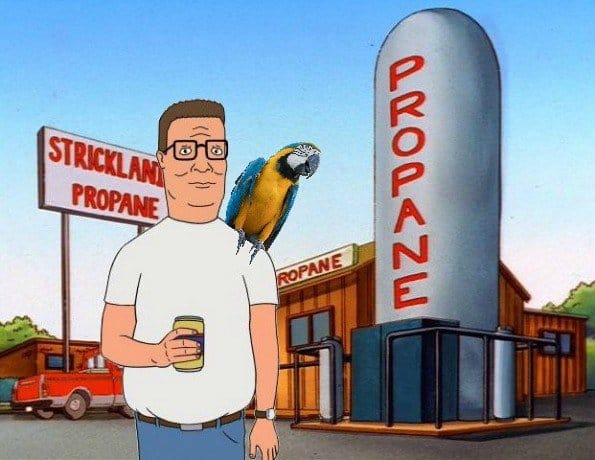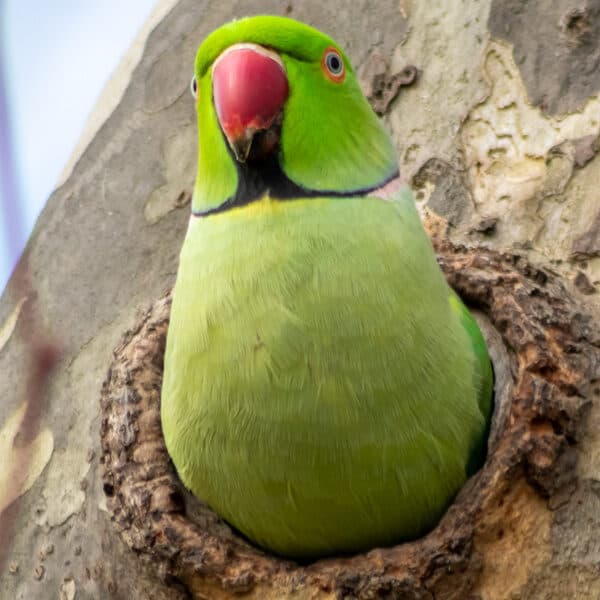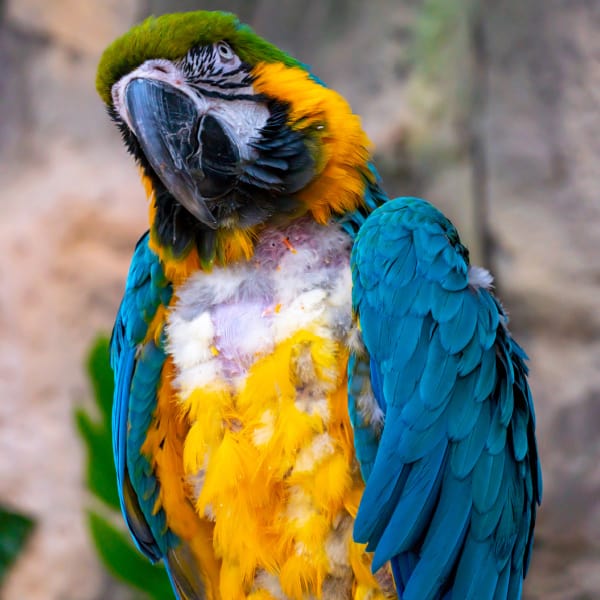Last Updated on by Mitch Rezman
Wondering if you can guide me with the care of my umbrella. Her vet is away on sick leave for a few months. I am her third owner.
I live in a two-room 35 ft camper trailer with six dogs and the bird. She likes to be around them – in her cage – and when they get treats she expects ( and gets) her own. They are her flock.
She has been a feather shredder since long before she came to me, about three years ago. She is also very indifferent to food. Her owner before me cared for her well and tried her hardest to get her to fresh fruit and veg. Her primary diet is Zupreem fruit blend, though her specific preference are the pink pieces. But she isn’t even very interested in eating.
Most times, if I soak till soft I can hand feed her 6 or so large pink Zupreem half-moon shaped pellets. If I am around she may eat a couple of dry ones and cashews. She has no interest in peanuts or almonds in the shell or sunflower seeds.
Birds in the aviary I volunteer at, hang out eagerly for their food, with nuts being the greatest treat. She will eat food I have chewed up, and after many attempts, I have got her to eat smidgins of chewed banana, apple, and red kidney beans. My vet told me to stop feeding her from my mouth; this was after she laid her first egg. She does get sexy with me sometimes.
She has laid a total of five eggs over the last eighteen months. I have just been reading your blog posts about lighting, cage setup, and toys. I do cover her cage, but the timing of this is extremely erratic, due to my life schedule. I sometimes leave in the morning and don’t get home till midnight or later. Or I come home briefly at between five and six to feed dogs and go. In her previous home, she was always covered at 9 pm and uncovered at 10-11 am.
We all inhabit the main room, which has a cage, kitchen, desk, and bed in it. The other room does have a second cage in it, but until recently I had an ailing senior dog in there. It is the room I use as the main entry and exit in winter, as it is much cooler and I try to preserve the heat in the or her room, and the only one with a dog door. I will be putting a washing machine in there soon.
Her current cage has a dome bird light I purchased from you, that gets turned on and off when I cover (with sheets) and uncover. But the timing of such is all over the place. I clearly also don’t have enough toys for her or not enough new ones.
I noticed the other day her lower beak is flaking and chipping in the little-finger-sized area closest to the tip. Is this a calcium deficiency?
She is all in all happy, we love each other very much, and I get her out of her cage every day to cuddle/groom for at least 30 mins each day, tho sometimes this is in the middle of the night when I get home and she is uncovered.
When it’s warm and sunny we go in the yard; she cannot fly due to feather stripping. She squawks if I leave the room. She did this some with her previous owner.
I had her cage near a huge picture window, as it gets lots of sunlight she seemed to enjoy, but a few months ago moved her to a corner with two small windows.
My main question is re sleeping and light. I clearly need to create a regular bed and waking up time, tho I am not sure exactly how.
Which room is better. I am most active in the main room, and there is a gas stove. But the other room is colder, will have a washer I need to use whenever I have time, and is where the dogs and I go in and out. If I covered her with a dark cover like you sell, will noise be a factor?
Unless I am home sleeping, the radio is always on. Daytime I could then put her in the main room where the dogs hang out when I am not there. The stove is there, but I am pretty paranoid about gas and her, so put the stove fan on and crack the kitchen window.
And what about her beak? I don’t recall seeing that before, and I looked at the Umbrellas at the rescue and no one seemed to have that. ( She was in the rescue for a while but wasn’t doing well so went to live with the rescue’s founder, her owner before me. She came to me after I had been visiting with her every day for a year, so we had bonded. She moved in with me as her owner had to go interstate for some months.
I would appreciate any guidance or advice you can offer. I really love her and do my best, but I was *never* a bird person prior to her. I couldn’t bear it if she was removed from my life.
With many thanks,
Annie
Greetings Annie
Let’s start with the lighting issue. I know from experience because we own a 29-foot travel trailer permanently parked, we know that in general, they do not have large windows allowing a lot of light. This goes beyond simply covering the cage which is an easy problem to solve.
You can get a timer to attach to the light. Set it to turn on and off every 12 hours – 7 o’clock, 8 o’clock or 9 o’clock whatever works for you and leave it. Do not change for daylight savings time. Birds don’t.
The light thing is confusing her circadian clock which is triggering egg production. That is where she may have a calcium deficiency which happens to brooding hens.
She should reside in the warmer room especially if she has lost many feathers due to plucking. Your vet was right to advocate not chewing her food up as human saliva is not good for birds. It can be toxic. Instead of offering her unshelled nuts try giving her shell on whole almonds and cracking open some walnuts to see if she might embrace those more.
We have two 10,000 BTU ventless heaters in our trailer powered by propane and have been bringing our birds with us for years No need to crack the window when you are cooking just creating more of a draft.
You may want to consider a different brand of bird food as Zupreem has a higher concentration of sugar than most pellets. Sugar is highly acidic and these pellets can sit in her crop for up to six hours before moving down to her first stomach which could also be a plucking trigger – birdie heartburn.
There are three ways of looking at the beak problem. The flaking can be caused by malnutrition. Usually a vitamin A deficiency, I would recommend moving her to a diet of Higgins Intune Pellets.
Higgins Safflower Gold would also work because it has fruits, nuts, seeds and pellets with more of a variety of flavor and texture which will be more interesting than straight pellets.
Parrot beaks will flake as they continuously grow much like our nails. Because she doesn’t have a lot of toys in the cage, she probably doesn’t have a lot of opportunities to use her beak to keep it in ideal shape which leads me to the next subject.
Another problem you’re having is that she is likely bored out of her mind with few toys and nothing to do. This also relates to the food because she would much rather work for the food than take it out of a bowl.
You can resolve this by creating a simple foraging box. Here is an example.
As for toys, you really don’t have to spend a lot of money. Here’s another video where I make about a dozen bird toys from parts that I got at the local dollar store for 10 or $12. The cooking spoons are great for umbrella cockatoos because they are prolific chewers and you are not offering her enough to use her beak.
So there are a couple of projects to start with, let me know how they work out and how you will continue from there.
Best of luck
Written by Mitch Rezman
Approved by Catherine Tobsing
Your Zygodactyl Footnote
Author Profile
Latest entries
 The Traveling BirdJune 26, 2025Can You Name 5 Parrot Species That Are Living Wild in the USA?
The Traveling BirdJune 26, 2025Can You Name 5 Parrot Species That Are Living Wild in the USA? Bird BehaviorJune 26, 2025How is it Parrots Are Problem Solvers Social Animals and Even Use Tools?
Bird BehaviorJune 26, 2025How is it Parrots Are Problem Solvers Social Animals and Even Use Tools? Bird & Parrot AnatomyJune 25, 2025How a Tiny Chemical Modification Makes Parrots Nature’s Living Paintings
Bird & Parrot AnatomyJune 25, 2025How a Tiny Chemical Modification Makes Parrots Nature’s Living Paintings PigeonsJune 20, 2025How Do Parrots Thrive in Cities Outside Their Native Habitats?
PigeonsJune 20, 2025How Do Parrots Thrive in Cities Outside Their Native Habitats?





